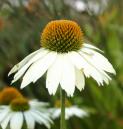
 The dried leaflets of Ca'ssia acutifo'lia Delile and C. angustifolia Vahl.
The dried leaflets of Ca'ssia acutifo'lia Delile and C. angustifolia Vahl.
BOTANICAL CHARACTERISTICS.—The acute-leaved senna, C. acutifolia, is a leafy shrub 2 to 5 feet high, bearing axillary racemes of yellow flowers. Legume flat, broadly oblong, very slightly curved inward, rounded at the extremities, terminating in an indurated and nearly obsolete style.
SOURCE.—Alexandria senna, exported by the way of Alexandria, is derived from Ca'ssia acutifo'lia, a species growing wild abundantly in upper Egypt, Nubia, etc. India senna (C. angustifo'lia) is obtained chiefly in Arabia, reaching western ports by way of Bombay and other Indian ports; sometimes called Mocha senna, as originally from that port. The same plant in cultivation yields Tinnevelly senna. The plant yields two annual crops, the best at the close of the rainy season (September), and the other during the dry season. Prepared for market by the natives, who carry it there on camels, where it is cleaned (garbled) and sold.
DESCRIPTION OF DRUG.—Both the Alexandria and the India senna consist of leaflets, a prominent distinction between the two being their size; the former, the acutifolia, is described as follows: Lanceolate or ovatelanceolate, 1.5 to 3 cm. long, 5 to 8 mm. broad; apex acute, mucronate; base unequal, acute; margin entire; upper surface light green, nearly glabrous, midrib sometimes depressed, veins of first order more or less prominent; under surface light grayish-green, midrib prominent, minutely pubescent, especially near the veins; petiole about 1 mm. long; texture coriaceous, fibrous; odor slight; taste somewhat bitter. Powder: Light green; non-secreting hairs 0.1 to 0.2 mm. long, one-celled, thick-walled, the wall of the upper part strongly cuticularized; calcium oxalate crystals rosette-shaped or in monoclinic prisms. The powder of Indian senna (C. angustifolia) is dark green and has relatively few non-secreting hairs. (For fuller particulars of the microscopical distinction of the two powders, see article by the author, "Amer. Jour. Pharm.," June, 1897, p. 298.) The India senna is by far a cleaner senna; senna should be free from stalks and other inert materials, and from Argel leaves (Solenostem'ma ar'gel, N. O. Asclepiadeae), which are thick, even at the base, and one-veined.
 Powder.—Characteristic elements: See Part iv, Chap. I, B.
Powder.—Characteristic elements: See Part iv, Chap. I, B.
CONSTITUENTS.—The purgative action of senna depends upon a sulphuretted glucoside, cathartic acid, insoluble in alcohol, soluble in water, but rendered partially or wholly inert by prolonged evaporation or boiling of its solution. Senna also contains chrysophan, phaeoretin, sennacrol, and glucosennin, C22H18O8; this latter is probably an emodin glucoside. The emodin is said to be identical with that found in Barbadoes and Cape Aloes. The principles giving the odor and taste to senna, also its griping action, are extracted by alcohol, somewhat affecting the cathartic action, however. Ash, not more than 12 per cent. not less than 3 per cent.; insoluble in HCl.
EMODIN TEST.—This test is applied to the emodin-bearing drugs such as Rhubarb, Aloes, Senna, etc. The tests as applied are practically the same. For Senna it is as follows: Mix 0.5 Gm. of powdered Senna with 10 mils of an alcoholic solution of potassium hydroxide (1 in 10), boil the mixture for about two minutes, dilute it with 10 mils of water and filter. Now acidify the filtrate with hydrochloric acid, shake it with ether; remove the ethereal layer and shake it with 5 mils of ammonia water; the latter is colored yellowish-red.
Preparation of Cathartic Acid.—Rhubarb or senna may be treated separately as follows: Moisten the drug with alcohol. Macerate 48 hours and percolate with strong alcohol till exhausted, to remove chrysophanic acid, resin, etc. Exhaust the marc with 60 per cent. alcohol. Evaporate the percolate at 50°C. to syrup, with constant stirring. Precipitate extract with 85 per cent. alcohol and filter to remove gum. The filtrate, after evaporating to a syrupy consistence, is added to a large excess of absolute alcohol. The brown precipitate thus produced is spread on glass to dry. It is then in light, shining scales.
ACTION AND USES.—A prompt and efficient cathartic. Its griping action may be prevented by combining it with an aromatic and one of the alkaline salts, or, as before stated, by first extracting the griping principle with alcohol. Dose: 2 to 8 dr. (8 to 30 Gm.).
OFFICIAL PREPARATIONS.
- Infusum Sennae Compositum (6 per cent., with manna and Epsom salts, each, 12 per cent., and fennel 2 per cent.), Dose: 1 to 2 ½ fl. oz. (30 to 75 mils).
- Syrupus Sennae (25 per cent. of Fl'ext.), 1 to 4 fl. dr. (4 to 15 mils).
- Fluidextractum Sennae, ½ to 4 fl. dr. (2 to 15 mils).
- Pulvis Glycyrrhizae Compositae (18 per cent.), 1 to 2 dr. (4 to 8 Gm.).
- Syrupus Sarsaparillae Compositus, 4 fl. dr. (15 mils).

